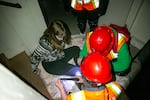
Annabeth Jamieson, age 11, is assisted by volunteers during a Neighborhood Emergency Teams training in Portland, Ore., on Apr. 12, 2025. Jamieson, who was instructed to act as if she had a broken leg, has volunteered as an actor twice before.
Anna Lueck for OPB
In a big, dark warehouse in Northeast Portland, police have built an entire city block. There are homes, storefronts, an apartment complex, streets, cars, you name it.
On a recent Saturday, the scene was staged with downed power lines, a burst gas main, smoke and a troupe of actors, painted with graphic injuries, like protruding bones and deep lacerations.
Trainees for Portland’s volunteer Neighborhood Emergency Teams were brought in and told there had been a massive earthquake. It was their job to go door-to-door and find out who needed help.
“Get out of my face!” one actor yelled after someone knocked on his door. “Are you from Comcast?”
The trainee explained, “No, we’re here from the Neighborhood Emergency Team. We’re checking to see how people are after the earthquake.”

Katie Waldo lies on a blanket while volunteering as an actor during a Neighborhood Emergency Teams training in Portland, Ore., on Apr. 12, 2025. Waldo, who joined NET in November 2024, says being part of the organization is "hope-giving."
Anna Lueck for OPB
The actors had been told not to make it easy. This man rattled on and on about Comcast, and he seemed more concerned about his TV than the health of his partner. But such behavior is not uncommon in emergencies, when traumatized people don’t understand the seriousness of a situation.
After several torturous minutes of discussion, the trainees gained access and found the man’s partner in a back room, seriously injured.
She needed immediate attention. But these trainees didn’t administer advanced first aid. They hadn’t been trained in that yet. Instead, it was their job to perform basic CPR and gather information as they waited for the professional EMTs.
Similar scenarios were playing out up and down the block.
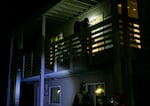
Volunteer teams check both floors of a mock apartment building for injured people during a Neighborhood Emergency Teams training scenario. The training session took place in the Portland Police Bureau's Scenario Village.
Anna Lueck for OPB
One woman begged trainees for help to find “Freda.”
It took several precious minutes until they learned Freda was a cat, not a person. Frightened children were crying in a blacked-out house. Someone started climbing a building to retrieve a dog.
It was mayhem.
And in the middle of all this, trainees were trying to find people and classify their injuries: green if they’re OK; yellow if they’re walking wounded; red if they need immediate attention.
There’s a 40% chance that Oregon will be hit by a major earthquake over the next 50 years. Those unlucky enough to get injured will likely be rescued by a neighbor, not an EMT. That’s because roads will be blocked and emergency services overwhelmed.
That’s why Portland has trained a small army of neighborhood volunteers to help in such an emergency. It speaks to the good will among many Portlanders that there are a couple hundred people on the waiting list to take the training.
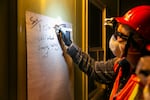
A volunteer writes down time entered and injured persons found in one building. The Neighborhood Emergency Teams program provides volunteers with training to help their neighbors in disaster situations.
Anna Lueck for OPB
Still, the city is always looking for more. There are no physical requirements and the average age is around 45.
“We say that everybody has a part to play in disaster response, literally everybody,” said Jeremy Van Keuren, who runs Portland’s Neighborhood Emergency Team program for the city’s Emergency Department.
Van Keuren said volunteers aren’t just waiting in dread for a looming earthquake, either. Last year, NET volunteers were deployed after the ice storms. They took pictures and logged the location of trees that had fallen on houses. That information helped incident command prioritize help.
“They also help Portland Fire & Rescue when there’s a windstorm, if power lines go down,” Van Keuren said.
They’ve even been deployed at the Rose Festival, to staff barricades.
Gresham educator Maria Ramirez hasn’t done any of that yet. At 44, she recently signed up as a new trainee. Dressed in her new NET gear, that is a red hard hat, a reflective yellow vest and an ID badge, she volunteered because she likes to help people, including her kids.
“Ever since I’ve started this, I’ve started making little packs of emergency packs for their vehicles and for home,” Ramirez said. “And giving them little pointers here and there.”
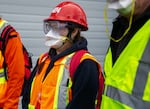
Maria Ramirez listens to instructions between practice rounds of a Portland Neighborhood Emergency Teams training session.
Anna Lueck for OPB
The training has made her much more aware of the bad things that can happen, she said, and of how she can help.
After an hour of confusing conversations and grizzly discoveries in the darkened warehouse, the exercise ended. Trainees left and the lights were turned back on.
Then John Light, one of the actors who’s been a NET volunteer for the last decade, walked out of a back storeroom, blood trickling down his leg.
“I have a broken tibia and I can’t move,” Light explained.
He had been waiting in the backroom for the last hour. But nobody went in to check on him. He said he’ll be talking to the new trainees later on about how to search more thoroughly.
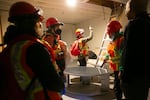
A volunteer team checks a mock apartment for injured people.
Anna Lueck for OPB
Over the last 30 years, some 4,000 residents from every Portland neighborhood have trained as NET volunteers. Many have gone on to specialize in medical assistance, or emergency radio. But all the while, the background hope is that they’ll never have to actually deal with The Big One.
Oregonians can learn about how to become more prepared for an earthquake by visiting publicalerts.org.
Portlanders who want to sign up for the free Neighborhood Emergency Team training can do so here.
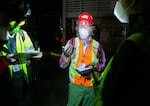
Douglas Young, center, gives instructions to his teammates while serving as team lead during a Neighborhood Emergency Teams training scenario. The volunteer teams were instructed to quickly assess potential hazards and classify people they discovered based on injury level.
Anna Lueck for OPB
